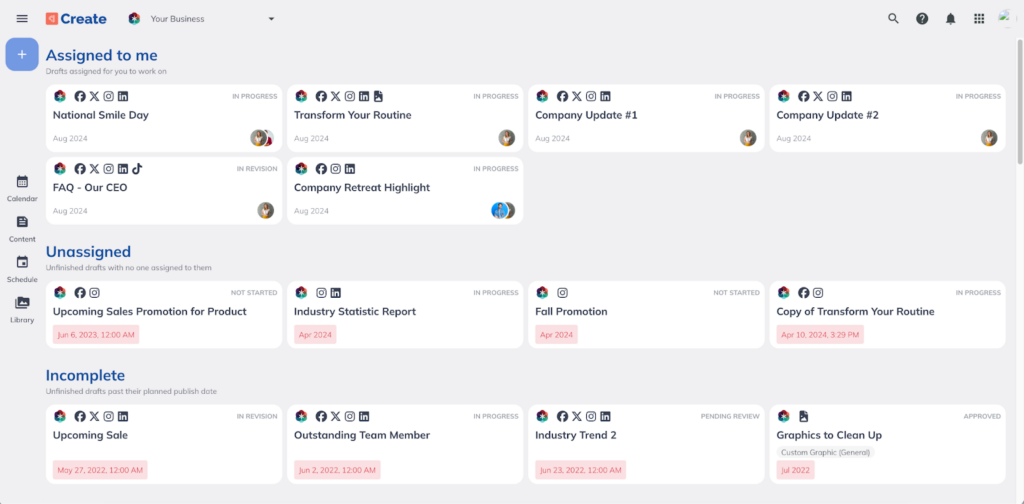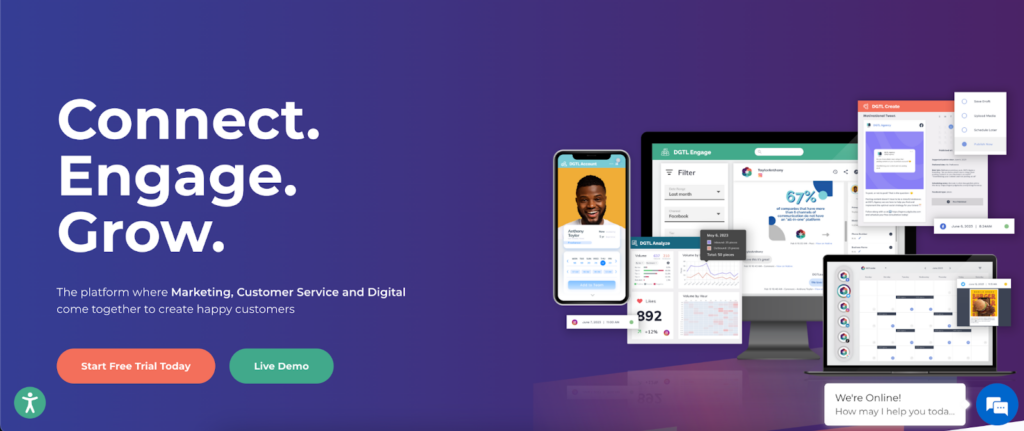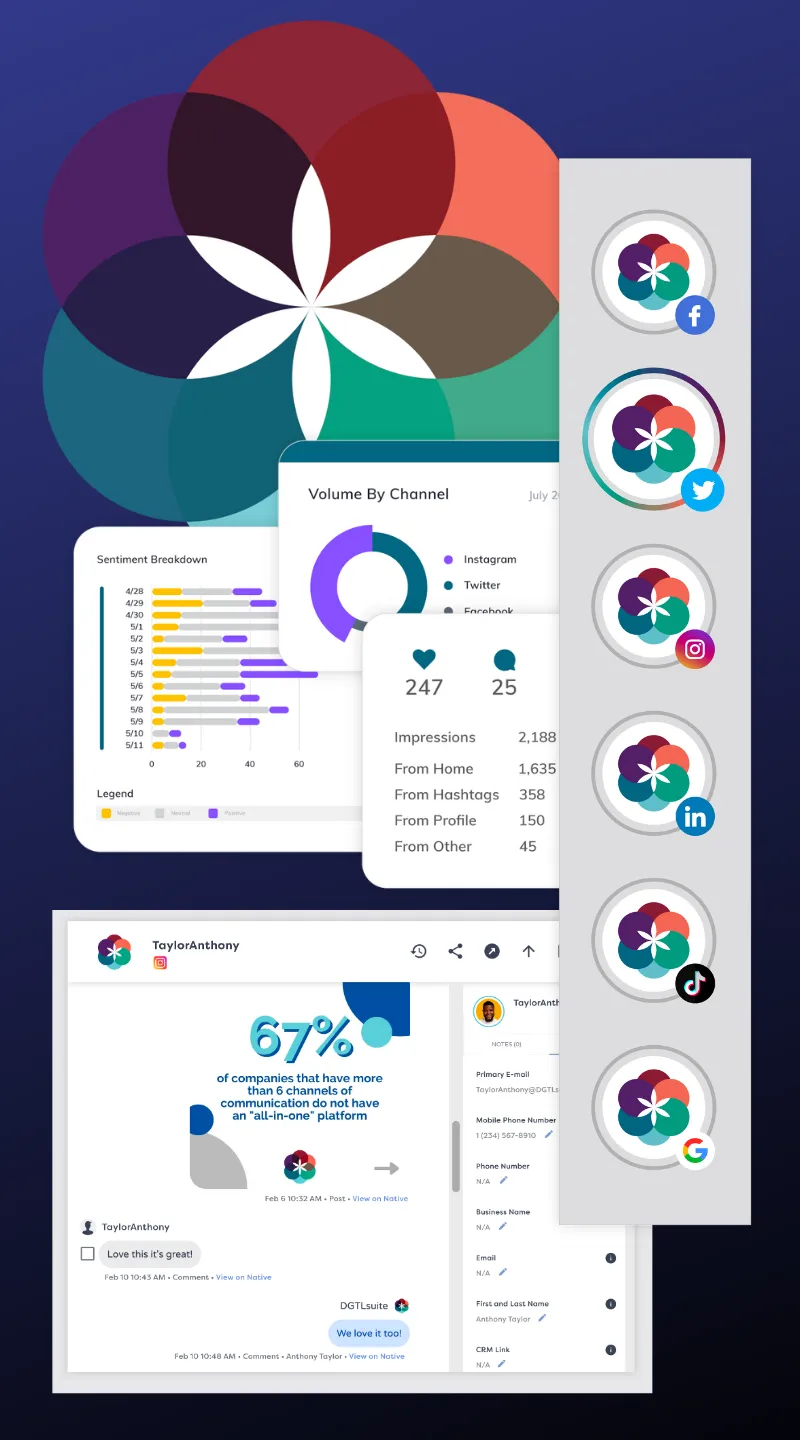Keeping up with social media can feel like a full-time job. Between scheduling posts, tracking engagement, and juggling multiple platforms, it’s easy to get overwhelmed.
That’s why so many businesses turn to social media management tools to save time and stay organized—but with so many options, picking the right one isn’t always easy.
CoSchedule and Buffer are two of the most popular choices, but they serve different needs. CoSchedule is best for teams that need a structured content calendar, while Buffer keeps things simple for small businesses and solo marketers who just want to schedule and track posts without the extra complexity.
But what if you need more than just scheduling? DGTLsuite offers a complete solution that covers social media, customer engagement, and automation—all in one place.
This breakdown will help you decide whether CoSchedule, Buffer, or DGTLsuite is the best fit for your needs.
What is CoSchedule?
CoSchedule is a content marketing and social media management platform designed to help businesses stay organized. Instead of juggling multiple tools for scheduling posts, planning campaigns, and keeping track of deadlines, CoSchedule brings everything into one place.

Source: G2
It’s mainly built for marketing teams and agencies that need a clear system to manage their content strategy. Think of it as a central hub where you can map out blog posts, social media updates, and email campaigns, all while keeping your team on the same page.
If you’re someone who loves structured workflows and detailed planning, CoSchedule can be a solid choice. But if you’re looking for a tool that also helps with audience engagement—like responding to comments or tracking social conversations—you might find it a bit limited.
What is Buffer?
Buffer is a social media management tool that helps businesses, creators, and teams plan, publish, and track their content across multiple social media accounts.
It’s known for its simple and easy-to-use interface, making it a great choice for those who want a no-fuss way to manage their social media presence.

Source: G2
Unlike more complex marketing platforms, Buffer focuses mainly on scheduling and publishing posts. It’s ideal for small businesses, solo entrepreneurs, and social media managers who need a straightforward way to keep their content calendar running smoothly.
One of Buffer’s biggest advantages is its affordability and ease of use. You don’t need a marketing background to figure it out—just connect your accounts, schedule your posts, and let Buffer do the rest.
However, if you need advanced features like content collaboration, workflow automation, or detailed campaign planning, it might feel a bit basic.
What is DGTLsuite?
DGTLsuite isn’t just another social media scheduler—it’s a full-scale digital marketing and customer engagement platform. Instead of juggling different tools for posting content, responding to customers, and analyzing performance, DGTLsuite brings it all under one roof.

What makes it stand out? It’s not just for social media. DGTLsuite pulls in conversations from email, SMS, website forms, and other digital channels, so your team can manage everything from one place. No more bouncing between platforms or missing customer messages.
It’s built for businesses that want more control over their digital presence—from marketing teams creating content to customer service reps handling support. With AI-powered tools, automation, and collaboration tools, DGTLsuite helps businesses work smarter, connect faster, and keep customers happy.
CoSchedule vs. Buffer vs. DGTLsuite: Features Comparison
Each of these tools helps with social media management, but they focus on different things. CoSchedule is built for content planning and team workflows, Buffer is all about simple scheduling, and DGTLsuite goes beyond social media by combining marketing, customer engagement, and automation.
Let’s break down what each tool offers.
CoSchedule
CoSchedule is a full marketing calendar that helps teams stay organized. If you like planning content in advance and keeping everything in one place, this tool is a good option.
Key Features
- Marketing calendar: Plan and schedule all your content, from blog posts to social media.
- Integrated marketing campaigns: Run multi-platform campaigns in a structured way.
- Team collaboration: Assign tasks, set deadlines, and keep everyone on track.
- Content organizer: Manage social media alongside emails and blog posts.
- Best time scheduling: Posts go live when engagement is highest.
CoSchedule is great for marketing teams that need a structured workflow. However, it doesn’t offer engagement tools, so if responding to comments or messages is a priority, you’ll need another tool for that.
Buffer
Buffer is a no-fuss scheduling tool that helps individuals and small teams plan and publish content with ease. It doesn’t come with complex features, which makes it super easy to use.
Key Features
- Post scheduling: Queue up content and publish it across major social media platforms, even Google Business Profile.
- Engagement tracking: Monitor how your posts are performing.
- Simple analytics: Get reports on reach, clicks, and audience interaction.
- Comment replies: Engage with your audience from one dashboard.
- Link shortening: Keep your posts clean with built-in URL shortening.
Buffer is best for solo marketers, small businesses, or anyone who just wants to schedule posts without the extra bells and whistles. But if you need team collaboration, automation, or a full content calendar, you might outgrow it fast.
DGTLsuite
DGTLsuite takes social media management to the next level. It’s not just about posting content—it helps businesses handle customer interactions, automate workflows, and analyze performance with AI-driven insights.

DGTLsuite boasts three apps to help you optimize your social media strategy:
- Create: Plan, schedule, and automate content across social media, email, and SMS—all from one place. Work with your team to draft, review, and optimize posts with AI-powered insights to boost engagement.
- Engage: Keep all your customer interactions in one inbox, whether they come from social media, email, SMS, or web forms. Respond faster, assign conversations to team members, and track interactions to stay organized.
- Analyze: Get AI-driven insights to see what’s working and what’s not. Track performance, measure engagement, and fine-tune your strategy based on real data.
Key Features
- Omnichannel management: Schedule posts across social media, email, SMS, and more.
- AI-powered insights: Get data-driven recommendations to improve engagement.
- Customer engagement: Respond to messages, comments, and inquiries from one place.
- Automation tools: Set up workflows to handle repetitive tasks.
- Collaboration hub: Keep marketing and customer service teams aligned.
DGTLsuite is perfect for businesses that want more than just a scheduler. If you’re looking for a tool that handles social media, customer interactions, and automation in one place, this is the best pick.
CoSchedule vs. Buffer vs. DGTLsuite: Pros and Cons
Taking a look at the features is a great first step to knowing which tool will work best for you, but they may not be enough. Let’s talk about the pros and cons of each tool.
CoSchedule
CoSchedule is built for marketing teams that need structure. It helps plan blog posts, email campaigns, and more. If you love working with a calendar-driven system, CoSchedule’s marketing suite keeps everything in one place.
But if you need engagement tools, it might feel a bit limited.
Pros:
- Great for teams that need structured content planning
- Includes a marketing calendar to organize everything in one view
- Helps with team collaboration by assigning tasks and tracking progress
- Supports multi-platform social campaigns
- Works well for managing different types of content, not just social media
Cons:
- Doesn’t include engagement tools like replying to comments
- Can feel overwhelming for solo users who only need scheduling
Buffer
Buffer is all about simplicity. If you’re looking for an easy way to schedule posts and track performance without extra complexity, this is a great choice. It’s ideal for individuals and small teams, but businesses needing collaboration features or detailed analytics might find it too simplistic.
Pros:
- Easy to use, even for beginners
- Affordable, with a free plan available
- Provides solid scheduling and basic analytics
- Includes engagement tools for responding to comments and messages
- Supports multiple social media platforms
Cons:
- Lacks advanced social media content planning and marketing workflow features
- Limited collaboration tools, making it less ideal for larger teams
- Doesn’t offer AI-powered insights or automation
DGTLsuite
DGTLsuite is a full digital marketing and customer engagement platform. Instead of just posting content, you can manage conversations, automate tasks, and track performance across multiple channels, including email, SMS, and website forms.
Essentially, it’s designed for businesses that need more than just a scheduling tool.
Pros:
- All-in-one platform for social media, email, SMS, and web interactions
- AI-powered insights help improve engagement and strategy
- Built-in automation tools save time on repetitive tasks
- Lets teams collaborate on content, customer interactions, and marketing efforts
- Supports customer service by consolidating messages from different digital platforms
- Scales easily for businesses that need more than just social media scheduling
- Provides a more complete solution than CoSchedule and Buffer
CoSchedule vs. Buffer vs. DGTLsuite: Who Is It Best For?
Not all social media tools work the same way, and the best choice depends on what you actually need. Some tools are great for organizing content, while others focus on easy scheduling or customer engagement.
Here’s how CoSchedule, Buffer, and DGTLsuite stack up based on who they’re best suited for.
CoSchedule
If you’re part of a marketing team that handles more than just social media, CoSchedule is a solid pick. It’s built for organized content planning, so if you love mapping out blog posts, email campaigns, and social media in a single calendar, this tool keeps everything in check.
However, if your focus is more on social media engagement—replying to comments, tracking interactions, or automating responses—CoSchedule won’t have what you need. It’s more about content planning than real-time engagement.
Buffer
Buffer is perfect for solo marketers, small business owners, and content creators who just want an easy way to schedule posts.
The interface is super simple, so you don’t need to spend time learning how to use it. If your goal is to schedule content, track basic analytics, and occasionally respond to comments, Buffer is a great fit.
That said, it’s not the best option if you need advanced planning tools, AI insights, or deep collaboration features. If your team is growing or you need more control over content workflows, you’ll likely outgrow Buffer pretty fast.
DGTLsuite
If you’re looking for more than just a scheduling tool, DGTLsuite is the way to go. It’s built for businesses that need social media management, customer engagement, and automation—all in one place.
Unlike CoSchedule and Buffer, DGTLsuite doesn’t just help you post content—it lets you manage conversations from multiple channels, automate repetitive tasks, and get AI-powered insights to improve your strategy.

It’s an excellent fit for businesses and teams that handle social media, email, SMS, and customer service together. If your company wants a smarter way to manage marketing and customer engagement without switching between tools, DGTLsuite makes that happen.
CoSchedule vs. Buffer vs. DGTLsuite: Pricing
Pricing plays a huge role in choosing the right tool, especially if you’re working with a tight budget or need a platform that scales as your business grows. Here’s a breakdown of what each tool costs and what you get for the price.
CoSchedule Pricing
CoSchedule has a free plan for a basic social calendar. The cheapest paid plan starts at $19 per month per user. This includes core features like social media automation, unlimited social media publishing, and social analytics, among others.
Pricing increases based on features, making it more suited for marketing teams that need structured workflows and collaboration tools.
Buffer Pricing
Buffer is the most affordable option, so it’s good for individuals and small businesses. It has a free plan that allows up to three social channels with basic scheduling features.
If you need more, paid plans start at $6 per month per social channel, along with basic features like analytics and post scheduling.
DGLTsuite Pricing
DGTLsuite offers several pricing plans to choose from. Single users can choose from any of the following:
- Create Only: Starts at $9 per month. Gives one user access to the Create platform for two social media accounts.
- Engage Only: Starts at $29 per month for one user and two social accounts. Lets you use the Engage platform.
- Basic: Offers all three platforms for $59 a month. Allows one user to manage five user accounts.
Meanwhile, teams can pick a plan that will work best for their needs:
- Pro: $179 per month for unlimited social media posts, user analytics, and other features from all three platforms.
- Business: Starts at $299 per month. Offers everything in Pro plus a 3TB content library, Zapier integrations, and other advanced features.
- Enterprise: Offers tailor-made plans for custom pricing.
Check out the pricing page to see which plan is perfect for you.
Find Every SMM Tool You Need with DGTLsuite
Choosing the right social media management tool depends on what your business needs most.
CoSchedule is great for teams that focus on content planning and workflow organization, while Buffer is ideal for solo users and small teams looking for a simple, budget-friendly scheduling tool. But if you need more than just scheduling, DGTLsuite is the clear winner.

With DGTLsuite, you’re not just posting content—you’re managing conversations, automating tasks, and using AI-driven insights to make better decisions. Instead of juggling multiple platforms for social media, email, SMS, and customer engagement, DGTLsuite brings it all into one powerful system.
Why settle for basic scheduling when you can have an all-in-one marketing and engagement solution? Get started with DGTLsuite today and see how it can transform the way you create, engage, and analyze your social media presence.
Book your discovery call now and take control of your social media strategy!
FAQs About CoSchedule vs Buffer
What is the difference between Planable and Coschedule?
Planable focuses on team collaboration with a visual approval workflow, while CoSchedule is a full content marketing calendar for managing blogs, emails, and social media. If you need workflow approvals, go with Planable. If you want broader marketing management, CoSchedule is the better fit.
What is better Hootsuite or Buffer?
Hootsuite is a full-scale social media management tool with team collaboration, analytics, and ad management suited for larger businesses. Buffer is simpler and budget-friendly, ideal for individuals and small teams that just need scheduling and engagement tracking for major social media channels.
What is a Buffer schedule?
A Buffer schedule is a pre-set posting schedule that automates when your content goes live. Once you add posts to your queue, Buffer automatically publishes them based on your chosen days and times.
What is better than Buffer?
For more than just scheduling, consider DGTLsuite, which includes automation, customer engagement, and AI insights. Hootsuite and Sprout Social also offer advanced analytics and team collaboration, but DGTLsuite provides the most complete solution.





